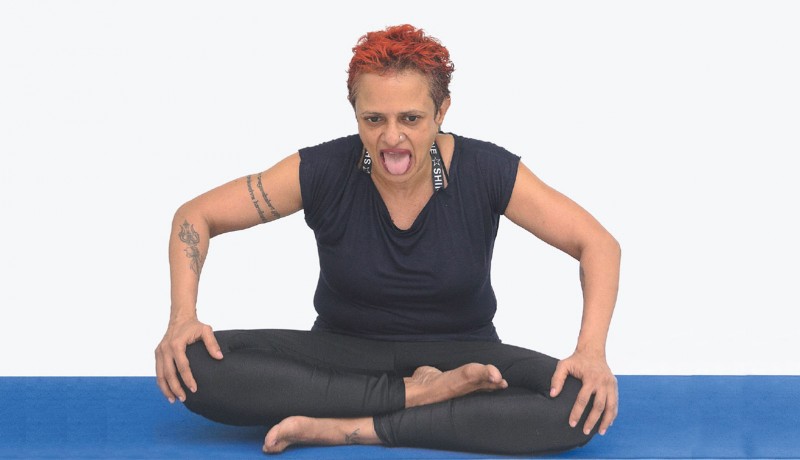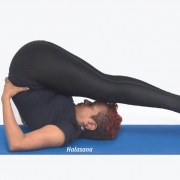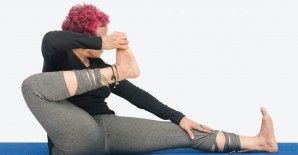
Columns

Shameem Akthar illustrates poses to tackle chronic indigestion
One of the most ill-diagnosed and ubiquitous problems is indigestion—all of us have been victims to this at some point in our lives. Indigestion itself is a symptom of an underlying cause. In fact, this is such a large field that even a medical practitioner would refer you to a specialist rather than treat it symptomatically. It is best to fix the underlying cause and choose remedies accordingly. Therefore, here, we offer complementary yogic practices that help you deal with the lifestyle triggers to this problem.
Some may be tracked common-sensically:
- Eating and talking. This means food is not chewed properly, so the first stage of digestion is already compromised and is passed on half-prepared to the gut.
- Drinking too much fluid while eating dilutes the stomach’s enzymes and reduces their efficacy.
- Not chewing food well enough and taking in too much air while eating. This happens when your teeth are sensitive or you are not focusing on your food (watching TV while eating, for instance). The old Eastern saying, to ‘drink your food and chew your drinks’, hints at how you must eat.
- Eating too much owing to stress. In fact, when you are stressed, the digestive system is in go-slow mode because the body’s resources are being directed to other more needy systems. So loading up on food will mean much of it will fester in your belly.
- Exercising immediately after eating. Even if you enjoy exercise, it is a stressful activity for the body. So, the same response as above occurs.
- Sleeping immediately after eating. Though postprandial sluggishness is normal, sleeping immediately after eating may create discomfort in the digestive system.
- Eating erratically, with irregular meal timings. The body likes to work according to a biological clock and inner timing. Having irregular meal timings throws not just the digestive system but other mechanisms also out of kilter.
Whatever the biological causes of your indigestion, some of these discomforting symptoms can be tackled by just tweaking certain lifestyle factors.
In yoga, the metabolic fire practice (agnisara kriya) is seen as a powerful cleansing and toning practice for the entire digestive tract. Pranayama or breathing practices like skull cleanser (kapalabhati) and bellows breathing (bhastrika) also tone it. The thunderbolt pose (vajrasana) has a nearmagical impact on the system too, because the blood flow towards the legs is totally blocked and redirected to the abdomen. Also, the heels press into an important acupressure point called vajra nadi that switches on the repairing energy line for the whole body. The stomach lock, called upward flying lock (uddiyana bandha), may be practised with pranayama to further impact the gut positively. It is really easy to line up the poses that work the belly—all those that give a strong pressure to the stomach may be included in this list: forward bends, backbends, spinal twists. So depending on your sadhana and regular practice, it is easy to create a sequence that addresses any chronic problem of indigestion you may have.
YOGIC MOVES
Dynamic plough pose (druta halasana)
Lie down on your back. Inhale. As you exhale, hoist your hips up in the shoulder stand (sarvangasana). Exhale; drop the legs behind in the plough (halasana). Breathe in and out deeply. Again, inhale to raise the legs back. As you exhale, slide down the hips till legs are fully on the ground. Lean your torso forward into a full forward bend (paschimottanasana).
This may be an intimidating flow of three poses but is actually negotiable for anyone with a regular practice. For those unable to drop the legs behind in the plough, you can use a yoga belt to ensure the legs go behind a bit and you can slide down forward. Even though you fully execute the plough, drawing the legs as far behind does exert a powerful but composite pressure on the abdomen, which has a positive impact overall. Another trick: you can position yourself at a wall, so the legs drop low till your feet rest on the wall as far down as possible.
Benefits: In the plough pose, there is a positive pressure on the stomach as well as the neck where the metabolic gland thyroid is located. Further, the spine is pulled out from its contracted state—as happens with stress. The anti-gravity impact of the inversions is more intense in the plough pose. In druta halasana, you have the combined benefits of three classic healers from the yogic sequence.
KNOW YOUR KRIYA
Dog panting breath (svana pranayama)
This may be done seated or standing. If standing, place palms loosely on knees, legs slightly apart. Seated, too, keep your hands on the knees. Bring your shoulders in, collapsing the belly inwards. Put the tongue out, beginning to pant lightly, with the focus only on the stomach’s in-out movement. Do 10 pants to complete a round. You can do three rounds. This must be done on an empty stomach, ideally first thing in the morning. You can repeat it later, before any pranayama practice at evening, but on an empty stomach. However, such heating practices must never be done if you suffer from inflammatory conditions such as boils, eruptions, ulcers, fever, etc. Benefits: This tones the stomach and digestive tract.
Shameem Akthar is a Mumbai-based yoga acharya. If you have any queries for her, mail us or email at contact.us@harmonyindia.org. (Please consult your physician before following the advice given here)
Photos: Haresh Patel Featured in Harmony — Celebrate Age Magazine February 2018
you may also like to read
-
Mental workout
Mukul Sharma tells you how to keep those grey cells ticking Everyone will ultimately lose his or her brain….
-
Helpline
Dr Harshbir Rana answers your queries on personal and social issues related to ageing, elder care and intergenerational relationships ….
-
Off the cuff
Raju Mukherji pays tribute to his first hero, Tenzing Norgay, an exemplary mountaineer Darjeeling, 1955. Dr ‘Pahari’ Guha Mazumdar….
-
Yoga RX
Shameem Akthar shows ways to control debilitating ankle pain through regular practice Ankle pain is so common and prevalent….








